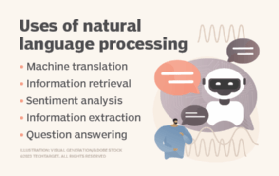
What does NLP mean for augmented analytics?
Explore how NLP is being used by augmented analytics platforms to improve employees' search capabilities, expand data visualization and build a data-driven culture.
Natural language processing is one of the most important features of augmented analytics platforms. The role of augmented analytics is to democratize data insights by simplifying tasks that have previously required specialized technical knowledge, such as integrating data sets or writing an SQL query.
Now, citizen data scientists (power users) and business users can discover many insights on their own. This allows data analysts to focus on more complex and sophisticated problem-solving.
"We have seen great customer adoption within our NLP capabilities, especially in helping make analytics consumable and easy for everyone. This has drastically helped many of our customers drive a data culture," said Arun Ulag, CVP of the Business Intelligence Platform at Microsoft.
What is NLP?
According to Gartner, NLP turns "text or audio speech into encoded, structured information, based on an appropriate ontology."
Augmented analytics uses two subtypes of NLP, which are natural language understanding (NLU) and natural language generation (NLG). NLU enables the platform to understand a user's query while NLG "narrates" data visuals.
NLU applies to text and audio. However, typed queries are more common than voice queries today for several reasons, most notably because the former is an easier problem to solve. In both cases, the augmented analytics platform must understand what the user is attempting to communicate. Since humans don't always say what they mean, augmented analytics must understand the user's intent.

One way to do that is to provide type-ahead assistance, such as the one used in Google Search. Qlik has an associative analytics engine that surfaces multiple insights related to a user's question. For example, if a user's query said, "What were Q1 sales in London?" the result would not simply be a number or a chart. Rather, insights might include comparisons of London sales to the sales in other parts of the world or the sales by teams or individuals associated with London.
"Our goal is to provide peripheral vision so that we can help you ask the question you didn't think about and have more 'aha! moments' with the data," said Elif Tutuk, VP of innovation and design at Qlik.
Does NLP benefit sophisticated users?
Although the point of augmented analytics is to help democratize analytics, the platforms also benefit data scientists and data analysts.
"It [saves] the sophisticated users from doing the mundane and lets data scientists focus on higher-level tasks," said Cindi Howson, chief data strategy officer at ThoughtSpot. "It also accelerates the time to collaborate on a model."
For example, if ThoughtSpot provided a business user with an insight, such as the sales of widgets are 300% higher in one zip code than another, the business user could use that insight to explain where the data scientists should focus their efforts.
Does NLP help less sophisticated users think analytically?
Just because augmented analytics is easy to use doesn't mean that users know how to think analytically.
"In many implementations, you're going to have to learn how to ask the question the right way to get the answer that you're looking for," said Brian Atkiss, director of applied intelligence solutions at Anexinet. "Some of that does require training and an understanding of how to use the technology, but I think that's a problem which will disappear over time. As the tools get better, they'll be able to use more natural language, so the need for training will go away."
ThoughtSpot's Howson agreed.
"I've always believed in the value of training, but gone are the days when we required anyone who wanted to be data-driven to go away for a two-day class," Howson said. "[The platform] really should be learning in context and lowering the skills required to get there. We still need experts, but for the masses, it's about removing the training requirement."
Microsoft's Ulag said NLP paired with an exploratory user experience allows users to make the best use of both worlds. Once a question has been answered, the resulting displays can be used to interact with other visuals on the page, which helps users discover key insights.
The road ahead
Voice-activated queries may eventually replace text queries. However, during the transition, both will coexist with text providing a safety net. That way, if NLU fails to understand a voice query, the user can simply type the query.
The next evolution may be augmented reality. For example, global professional services firm Genpact and some of its consumer packaged goods clients are experimenting with the technology so users can "see" product inventory levels in a store, or can discover that three product categories are associated with four specific stores. Like other forms of augmented analytics, the insights aid decision-making and facilitate data-driven collaboration. Right now, augmented reality as an augmented analytics feature is at the experimental stage, but Genpact SVP Amaresh Tripathy and others believe this is where the market is heading.







